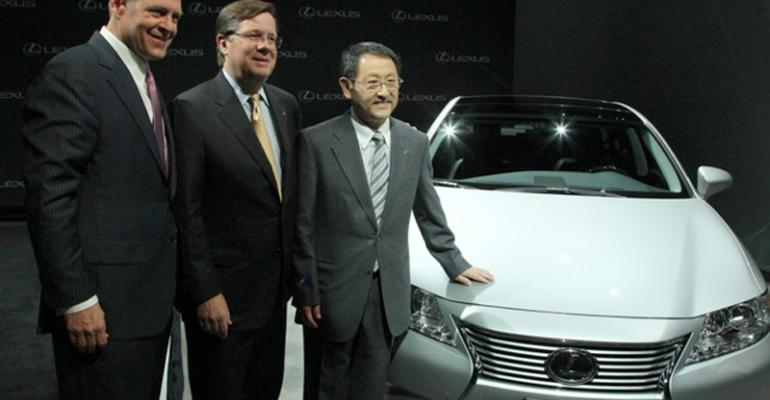NEW YORK – A new, strengthened American management team is being credited with triggering a speedy, final go-decision on plans to build the Lexus ES sedan at Toyota’s Georgetown, KY, assembly plant in the U.S.
In confirming what he calls the “worst-kept secret at Toyota,” CEO Akio Toyoda says here today the auto maker will build the ES on an exclusive line that will be added at the plant in time for a 2015 launch.
Toyota will invest $360 million to expand and tool up the facility for the program, and the state will kick in a reported $146.5 million in tax abatements to support the project.
The auto maker has been considering adding Lexus ES sedan output in North America for at least a year. But Toyoda credits the decision to pull the trigger on the plan to a reorganization of its management ranks in March that is giving U.S. executives a stronger say at the company’s Tokyo headquarters.
Among the changes, Jim Lentz was named CEO of the North American region and senior manager of the parent company, and Mark Templin, who headed Lexus in the U.S., now has responsibility for the brand worldwide.
Former General Motors executive Mark Hogan, who got to know Toyoda during his days at the two auto makers’ New United Motor Mfg. joint venture in California, joined the Toyota board as part of the reorganization.
“I’m very confident in this new leadership team,” Toyoda says. “They made the decision in less than one month to bring a Lexus model to U.S. It’s a new team, a new beginning and a new Lexus.”
Lentz also attributes the move to the company’s reshuffled management ranks and says the final decision to bring the ES to the U.S. was made 30 days ago.
Capacity for the ES will be 50,000 units annually, about two-thirds of the volume Lexus expects to need in North America, Templin says. The remaining 25,000 will continue to be imported from the Kyushu, Japan, plant, including all ES Hybrids.
Toyota says it sold 58,850 ES cars in North America last year and has delivered 1.2 million since 1990.
With the addition of the sedan at Kentucky and sourcing of the RX cross/utility vehicle in Canada, Lexus now will build its two highest-volume U.S. vehicles in North America.
Toyota says the shift of some production to the U.S. won’t lower Kyushu’s annual output and that the auto maker is sticking with its pledge to build 3 million vehicles per year in Japan going forward.
“This is a new global Lexus,” Templin says of the sourcing move.
The project will add 750 jobs at the Georgetown plant, bringing employment to 7,400 people. The facility, which produces the Camry, Avalon and Venza and makes 4-cyl. and V-6 engines, currently has annual capacity for about 550,000 vehicles.
Only the most experienced Kentucky workers will be assigned to the ES line, joined by veteran employees from other North American plants. New hires will be assigned to Toyota-brand production.
The auto maker says it will build the Lexus cars on an exclusive line because that’s what it does at its other facilities in Japan and Canada. Templin says he is confident the quality of the cars produced in Georgetown will be identical to that from Kyushu.
The strategy to shift production not only will help put vehicles on U.S. dealer lots but also allow the auto maker to avoid some of the impact from fluctuating yen-dollar exchange rates, Toyoda says.
The Georgetown expansion is just the latest in a list of North American investments by Toyota over the past 17 months that have totaled $2 billion and added 4,200 jobs.
Toyota “already has a massive presence in North America,” Lentz notes, with 14 plants and seven of every 10 vehicles sold in the region produced locally. The auto maker doesn’t reveal how much domestic content the Kentucky-built ES will have at launch, but Lentz says most models average 75%, with the Camry and Avalon at 90%.
The U.S. is Lexus’ largest market, followed by China, Japan, Russia and the Middle East.
– with David E. Zoia in Southfield, MI.





